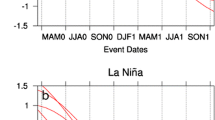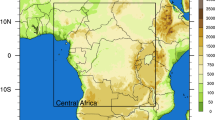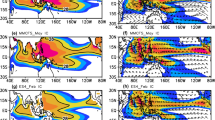Abstract
The present study is a preliminary interrogation of the ability of ten Earth System Models (ESMs) from the fifth phase of coupled model intercomparison project to characterize seasonal and annual mean precipitation cycle over the Greater Horn of Africa region. Each ESM had at least 2 ensemble members. In spite of distributional anomalies of observations, ESM ensemble means were examined on the basis of gridded precipitation data. Majority of the ten ESMs analyzed correctly reproduce the mean seasonal and annual cycle of precipitation for the period 1979–2008 as compared to gridded satellite-derived observations. At the same time our analysis shows significant biases in individual models depending on region and season. Specifically, a modest number of models were able to capture correctly the peaks of bimodal (MAM and OND) and JJAS rainfall while a few either dragged the onset to subsequent months or displaced the locations of seasonal rainfall further north. Nearly all models were in agreement with their representation of the zonal orientation of spatial pattern of the leading EOF rainfall modes; more so, enhanced precipitation over the Indian Ocean and a dipole mode of precipitation pattern are captured in the first and second mode respectively. Further, the corresponding EOF time series of the ESMs rainfall modes were all in phase with observations. However, all models output were positively biased against observations, with large medians and varied range of anomalies. Therefore, caution needs to be taken when choosing models for applications over the region, especially when ensemble means have to be considered.








Similar content being viewed by others
References
Adler RF, Huffman GJ, Chang A, Ferraro R, Xie PP, Janowiak J, Rudolf B, Schneider U, Curtis S, Bolvin D, Gruber A, Susskind J, Arkin P, Nelkin E (2003) The version-2 global precipitation climatology project (GPCP) monthly precipitation analysis (1979–present). J Hydrometeorol 4(6):1147–1167
Anyah RO, Qiu W (2011) Characteristic 20th and 21st century precipitation and temperature patterns and changes over the Greater Horn of Africa. Int J Climatol 31. doi:10.1002/joc.2270
Anyah RO, Semazzi FH (2006) Climate variability over the Greater Horn of Africa based on NCAR AGCM ensemble. Theoret Appl Climatol 86:39–62
Anyamba A, Linthicum KJ, Small JL, Collins KM, Tucker CJ, Pak EW, Britch SC, Eastman JR, Pinzon JE, Russel KL (2012) Climate teleconnections and recent patterns of human and animal disease outbreaks. PLoS Negl Trop Dis 6(1):e1465
Arakawa A, Shubert WH (1974) Interaction of a cumulus cloud ensemble with the large-scale environment, Part 1. J Atmos Sci 31:674–701
Arkin PA, Rao AVRK, Kelkar RR (1989) Large-scale precipitation and outgoing longwave radiation from INSAT-1B during the 1986 southwest monsoon season. J Clim 2:619–628
Bentsen M, Bethke I, Debernard JB, Iversen T, Kirkevåg A, Seland Ø, Drange H, Roelandt C, Seierstad IA, Hoose C, Kristjansson JE (2012) The Norwegian earth system model, NorESM1-M—Part 1: description and basic evaluation. Geosci Model Dev Discuss 5:2843–2931
Black E, Slingo J, Sperber KR (2003) An observational study of the relationship between excessively strong short rains in coastal East Africa and Indian Ocean SST. Mon Weather Rev 31:74–94
Brands S, Taboada JJ, Cono AS, Sauter T, Schneider C (2011) Statistical downscaling of daily temperatures in the NW Iberian Peninsula from global climate models: validation and future scenarios. Clim Res 48(2–3):163–176
Brands S, Gutiérrez JM, Herrera S, Cofiño AS (2012) On the use of reanalysis data for downscaling. J Clim 25:2517–2526
Bretherton CS, Smith C, Wallace JM (1992) An intercomparison of methods of finding coupled patterns in climate data. J Clim 5:541–560
Bretherton CS, McCaa JR, Grenier H (2004) A new parameterization for shallow cumulus convection and its application to marine subtropical cloud-topped boundary layers. Part I: description and 1-D results. Mon Wea Rev 132:864–882
Dee DP et al (2011) The ERA-Interim reanalysis: configuration and performance of the data assimilation system. Q J R Meteorol Soc 137:553–597
Del Genio AD, Yao M-S (1993) Efficient cumulus parameterization for long-term climate studies: the GISS scheme. The representation of cumulus convection in numerical models. Meteor Monogr 46:181–184
Dinku T, Ceccato P, Grover-Kopec E, Lemma M, Connor SJ, Ropelewski CF (2007) Validation of satellite rainfall products over East Africa’s complex topography. Int J Remote Sens 28(7):1503–1526
Diro GT, Grimes DIF, Black E (2011) Teleconnections between Ethiopian summer rainfall and sea surface temperature: part I observation and modeling. Clim Dyn 37:103–119
Dommenget D, Latif M (2002) A Cautionary Note on the Interpretation of EOFs. J Clim 15(2):216–225
Donner LJ et al (2011) The dynamical core, physical parameterizations, and basic simulation characteristics of the atmospheric component AM3 of the GFDL global coupled model CM3. J Clim 24:3484–3519
Emanuel KA, Rothman MZ (1999) Development and evaluation of a convection scheme for use in climate models. J Atmos Sci 56:1756–1782
Githeko AK, Lindsay SW, Confalonieri UE, Patz JA (2000) Climate change and vector-borne diseases: a regional analysis. Bull World Health Organ 9:1136–1147
Grandpeix JY, Phillips V, Tailleux R (2004) Improved mixing representation in Emanuel’s convection scheme. Q J R Meteor Soc 130:3207–3222
Guha-Sapir D, Vos F, Below R, Ponserre S (2011) Annual disaster statistical review 2010: the numbers and trends. Centre for Research on the Epidemiology of Disasters (CRED). The National Academies Press, Washington
Hastenrath S, Polzin D, Mutai C (2007) Diagnosing the 2005 drought in equatorial East Africa. J Clim 29:4628–4637
Hastenrath S, Polzin D, Mutai C (2010) Diagnosing the droughts and floods in equatorial East Africa during Boreal Autumn 2005–08. J Clim 23:813–817
Hellmuth ME, Moorhead A, Thomson MC, Williams J (2007) Climate risk management in Africa: learning from practice. International Research Institute for Climate and Society (IRI), New York
Huffman GJ et al (1996) The Global Precipitation Climatology Project (GPCP) combined precipitation dataset. Bull Am Meteor Soc 77:5–20
Huffman GJ, Adler RF, Bolvin DT, Gu G, Nelkin EJ, Bowman KP, Stocker EF, Wolff DB (2006) The TRMM multisatellite precipitation analysis (TMPA): quasi-global, multiyear combined-sensor precipitation estimates at fine scales. J Hydrometeor 8:38–55
Indeje M, Semazzi FHM, Ogallo LJ (2000) ENSO signals in East African rainfall seasons. Int J Climatol 20:19–46
IPCC (2007) Climate change 2007: the physical science basis. Contribution of working group I to the fourth assessment. In: Solomon S, Qin D, Manning M, Chen Z, Marquis M, Averyt KB, Tignor M, Miller HL (eds) Report of the intergovernmental panel on climate change. Cambridge University Press, Cambridge
Kijazi AL, Reason CJC (2009a) Analysis of the 2006 floods over northern Tanzania. Int J Climatol 29:955–970
Kijazi AL, Reason CJC (2009b) Analysis of the 1998 to 2005 drought over the northeastern highlands of Tanzania. Clim Res 38:209–223
Knutti R, Furrer R, Tebaldi C, Cermak J, Meehl GA (2010) Challenges in combining projections from multiple models. J Clim 23:2739–2756
Kummerow C et al (2000) The status of the tropical rainfall measuring mission (TRMM) after two years in orbit. J Appl Meteor 39:1965–1982
Kummerow CD, Ringerud S, Crook J, Randel D, Berg W (2011) An observationally generated a priori database for microwave rainfall retrievals. J Atmos Ocean Technol 28:113–130
Lee HT, Heidinger AK, Gruber A, El lingson RG (2004) The HIRS outgoing longwave radiation product from hybrid polar and geosynchronous satellite observations. Adv Space Res 33:1120–1124
Lee HT, Gruber A, Ellingson RG, Laszlo I (2007) Development of the HIRS outgoing longwave radiation climate data set. J Atmos Ocean Technol 24:2029–2047
Legates DR, Willmott CJ (1990) Mean seasonal and spatial variability in gauge-corrected, global precipitation. Int J Climatol 10:111–127
Liebmann B, Smith CA (1996) Description of a complete (interpolated) outgoing longwave radiation dataset. Bull Am Meteorol Soc 77:1275–1277
Nicholson SE (1996) A review of climate dynamics and climate variability in eastern Africa. In: Johnson TC, Odada E (eds) The limnology, climatology and palaeoclimatology of the East African Lakes. Gordon and Breach, Amsterdam, pp 25–56
Nicholson SE, Kim J (1997) Relationship of ENSO to African rainfall. Int J Climatol 17:117–135
Nicholson SE, Selato JC (2000) The influence of La Niña on African rainfall. Int J Climatol 20:1761–1776
Nkomo JC, Nyong AO, Kulindwa K (2006) The impacts of climate change in Africa. Final draft submitted to the Stern review on the economics of climate change, pp 51
Nordeng TE (1994) Extended versions of the convective parameterization scheme at ECMWF and their impact on the mean and transient activity of the model in the tropics. Tech. Rep. 206, ECMWF, Reading
Ogallo LJ (1988) Relationships between seasonal rainfall in East Africa and the Southern Oscillation. J Climatol 8:31–43
Ogutu JO, Owen-Smith N (2003) ENSO, rainfall and temperature influences on extreme population declines among African savanna ungulates. Ecol Lett 6:412–419
Ogutu JO, Owen-Smith N (2007) Oscillations in large mammal populations: are they related to predation or rainfall? Afr J Ecol 43:332–339
Ottichilo WK, De Leeuw J, Skidmore AK, Prins HHT, Said MY (2000) Population trends of large non-migratory wild herbivores and livestock in the Masai Mara ecosystem, Kenya, between 1977 and 1997. Afr J Ecol 38:202–216
Pan DM, Randall DA (1998) A cumulus parametrization with a prognostic closure. Q J R Meteor Soc 124:949–981
Patz JA, Githeko AK, McCarty JP, Hussein S, Confalonieri U, de Wet N (2003) Climate change and infectious diseases. In: McMichael A, Campbell-Lendrum D, Corvalan C, Ebi K, Githeko A, Scheraga J, Woodward A (eds) Climate change and human health: risks and responses. World Health Organization, Geneva, pp 103–132
Raddatz TJ, Reick CH, Knorr W, Kattge J, Roeckner E, Schnur R, Schnitzler KG, Wetzel P, Jungclaus J (2007) Will the tropical land biosphere dominate the climate-carbon cycle feedback during the twenty-first century? Clim Dyn 29(6):565–574
Rotstayn LD (1998) A physically based scheme for the treatment of stratiform clouds and precipitation in large-scale models. II: comparison of modelled and observed climatological fields. Q J R Meteorol Soc 124:389–415
Rotstayn LD, Collier MA, Dix MR, Feng Y, Gordon HB, O’Farrell SP, Smith IN, Syktus J (2009) Improved simulation of Australian climate and ENSO-related climate variability in a GCM with an interactive aerosol treatment. Int J Climatol 30:1067–1088
Rotstayn LD, Jeffrey SJ, Collier MA, Dravitzki SM, Hirst AC, Syktus JI, Wong KK (2012) Aerosol-induced changes in summer rainfall and circulation in the Australasian region: a study using single-forcing climate simulations. Atmos Chem Phys 12:5107–5188
Saji NH, Goswami BN, Vinayachandran PN, Yamagata T (1999) A dipole mode in the tropical Indian Ocean. Nature 401:360–363
Scinocca JF, McFarlane NA, Lazare M, Li J, Plummer D (2008) The CCCmathird generation AGCM and its extension into the middle atmosphere. Atmos Chem Phys 8:7055–7074
Seland O, Iversen T, Kirkevag A, Storelvmo T (2008) Aerosol-climate interactions in the CAM-Oslo atmospheric GCM and investigation of associated basic shortcomings. Tellus A 60(3):459–491
Shongwe ME, van Oldenborgh GJ, van den Hurk BJJM, de Boer B, Coelho CAS, van Aalst MK (2009) Projected changes in mean and extreme precipitation in Africa under global warming. Part I: southern Africa. J Clim 22(13):3819–3837
Shongwe ME, van Oldenborgh GJ, van den Hurk B, van Aalst M (2011) Projected changes in mean and extreme precipitation in Africa under global warming. Part II: East Africa. J Clim 24:3718–3733
Sylla MB, Giorgi F, Coppola E, Mariotti L (2012) Uncertainties in daily rainfall over Africa: assessment of gridded observation products and evaluation of a regional climate model simulation. Int J Clim. doi:10.1002/joc.3551
Taylor KE, Stouffer RJ, Meehl GA (2012) An overview of the CMIP5 and the experiment design. Bull Am Meteor Soc 93(4):485–498
Tebaldi C, Smith RL, Nychka D, Mearns LO (2005) Quantifying uncertainty in projections of regional climate change: a Bayesian approach to the analysis of multimodel ensembles. J Clim 18:1524–1540
The Stockholm Environment Institute (2009) (SEI Oxford Office) Economics of climate change in Rwanda. Stockholm Environment Institute, Stockholm
Tiedtke M (1989) A comprehensive mass flux scheme for cumulus parameterization in large-scale models. Mon Weather Rev 117(8):1779–1800
van Oldenborgh GJ, Philip SY, Collins M (2005) El Niño in a changing climate: a multi-model study. Ocean Sci 1:81–95
Watanabe S, Hajima T, Sudo K, Nagashima T, Takemura T, Okajima H, Nozawa T, Kawase H, Abe M, Yokohata T, Ise T, Sato H, Kato E, Takata K, Emori S, Kawamiya M (2011) MIROC-ESM 2010: model description and basic results of CMIP5- 20c3 m experiments. GMD 4(4):845–872
Weare BC, Navato AR, Newell RE (1976) Empirical orthogonal analysis of pacific sea surface temperatures. J Phys Oceanogr 6(5):671–678
Webster PJ, Moore AM, Loschnigg JP, Leben RR (1999) Coupled ocean-atmosphere dynamics in the Indian Ocean during 1997–1998. Nature 401:356–360
Williams A, Funk CA (2011) Westward extension of the warm pool leads to a westward extension of the Walker circulation, drying eastern Africa. Clim Dyn 37:2417–2435
World Bank (2006) Kenya Adaptation to Climate Change in Arid Lands (KACCAL), GEF Project Brief. World Bank, Washington
Xie P, Arkin PA (1997) Global precipitation: a 17-year monthly analysis based on gauge observations, satellite estimates, and numerical model outputs. Bull Am Meteor Soc 78:2539–2558
Xie P, Arkin PA (1998) Global monthly precipitation estimates from satellite-observed outgoing longwave radiation. J Clim 11:137–164
Xie P, Janowiak JE, Arkin JA, Adler R, Gruber A, Ferraro R, Huffman GJ, Curtis S (2003) GPR pentad precipitation analyses: an experimental dataset based on gauge observations and satellite estimates. J Clim 16:2197–2214
Yamamoto MK, Furuzawa FA, Higuchi A, Nakamura A (2008) Comparison of diurnal variations in precipitation systems observed by TRMM PR, TMI, and VIRS. J Clim 21:4011–4028
Yao M-S, Cheng Y (2012) Cloud simulations in response to turbulence parameterizations in the GISS model E GCM. J Clim 25:4963–4974
Yukimoto S et al (2006) Present-day climate and climate sensitivity in the Meteorological Research Institute Coupled GCM, Version 2.3 (MRI-CGCM2.3). J Meteor Soc Jpn 84:333–363
Zeleke T, Giorgi F, Mengistu Tsidu G, Diro GT (2012) Spatial and temporal variability of summer rainfall over Ethiopia from observations and a regional climate model experiment. Theor Appl Climatol. doi:10.1007/s00704-012-0700-4
Zhang GJ, McFarlane NA (1995) Sensitivity of climate simulations to the parameterization of cumulus convection in the Canadian climate centre general circulation model. Atmos Ocean 33:407–446
Acknowledgments
For their roles in producing, coordinating, and making available the CMIP5 model output, we acknowledge the climate modeling groups, the World Climate Research Programme’s (WCRP) Working Group on Coupled Modelling (WGCM), and the Global Organization for Earth System Science Portals (GO-ESSP). We also thank two anonymous reviewers for their constructive comments. This research was supported by National Science Foundation (NSF) under Grant Grant #: AGS 0854615.
Author information
Authors and Affiliations
Corresponding author
Rights and permissions
About this article
Cite this article
Otieno, V.O., Anyah, R.O. CMIP5 simulated climate conditions of the Greater Horn of Africa (GHA). Part 1: contemporary climate. Clim Dyn 41, 2081–2097 (2013). https://doi.org/10.1007/s00382-012-1549-z
Received:
Accepted:
Published:
Issue Date:
DOI: https://doi.org/10.1007/s00382-012-1549-z




